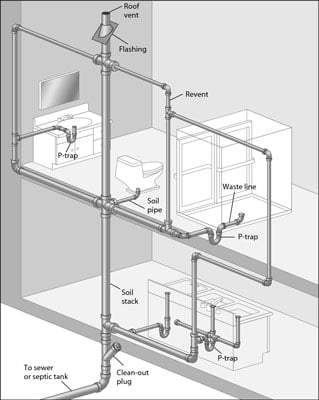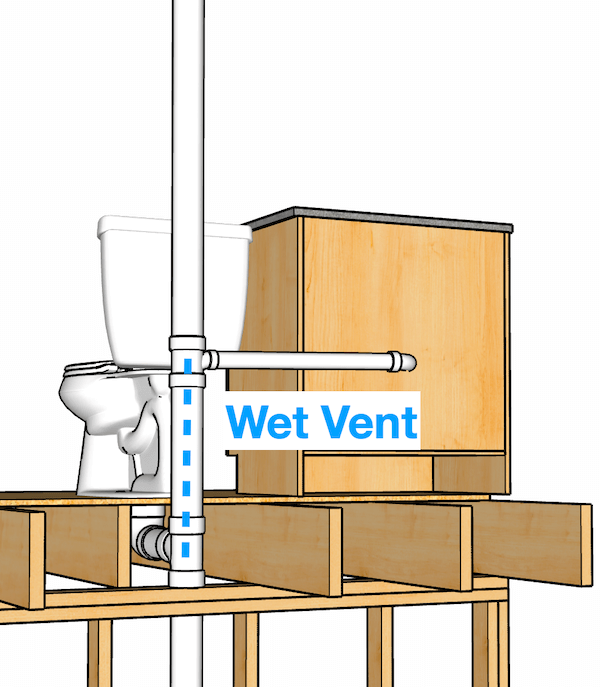The Way Adequate Ventilation Protects Your Plumbing System
The Way Adequate Ventilation Protects Your Plumbing System
Blog Article
We've encountered this great article involving The Upsides of Proper Ventilation in Plumbing Design down the page on the internet and decided it made perfect sense to talk about it with you over here.

Appropriate ventilation in plumbing systems is usually ignored, yet it is critical for maintaining the performance and safety and security of your home's plumbing. Ventilation aids manage atmospheric pressure, protect against the build-up of unsafe gases, and guarantee the efficient elimination of waste. In this guide, we will discover the importance of proper pipes ventilation, exactly how it works, and the advantages it brings to your plumbing system.
Just How Ventilation Functions in Plumbing Equipments
Air Pressure Policy
Correct ventilation keeps balanced air pressure within the plumbing system. When water moves through pipelines, it displaces air. Without appropriate ventilation, this variation can produce unfavorable pressure, leading to slow drains pipes or siphoning of water from catches, which can cause unpleasant smells to leak right into the home.
Preventing Drain Gas Accumulation
Among one of the most crucial functions of plumbing vents is to avoid drain gases, such as methane and hydrogen sulfide, from collecting within the home. These gases can present major health risks and are highly combustible. Vent pipelines enable these gases to leave securely outside.
Aiding in Waste Elimination
Air flow helps in the efficient removal of wastewater by stopping airlocks in the drainage system. When air can flow openly via the vents, it enables water and waste to flow smoothly via the pipelines, minimizing the risk of clogs and backups.
Advantages of Correct Ventilation
Boosted System Performance
Correctly aerated plumbing systems run more successfully, with less blockages, faster draining pipes, and much less stress on the pipelines. This efficiency prolongs the life expectancy of the pipes system.
Improved Air Quality
By stopping sewage system gases from entering your home, correct ventilation contributes to better indoor air high quality, making your living setting healthier and extra comfy.
Stopping Water Damage
Ample ventilation helps prevent water from being siphoned out of catches, which can bring about sewage system gases going into the home and triggering water damages in time.
Actions to Make Certain Appropriate Air Flow
Consulting Plumbing Codes
Constantly speak with regional pipes codes when designing or modifying your plumbing system. These codes give the necessary guidelines for proper airing vent and ensure your system satisfies security criteria.
Normal Inspection and Maintenance
Routine examinations can aid identify possible air flow concerns prior to they end up being significant problems. Upkeep jobs, such as cleaning air vent pipes and looking for clogs, are vital for keeping the system in good working order.
Expert Installment
For new installations or major adjustments, it's smart to employ a specialist plumbing professional. They have the proficiency to guarantee the ventilation system is correctly designed and mounted according to code.
Understanding Ventilation in Pipes
Air flow in plumbing describes the network of pipelines that enable air to stream through the water drainage system. These vents offer several purposes, consisting of regulating air pressure within the pipelines, protecting against sewer gases from going into the home, and helping in the smooth circulation of wastewater.
Sorts Of Plumbing Vents
Main Heap Vent
The major stack vent, also known as the air vent pile, is the key air vent in a pipes system. It extends from the major drainpipe align with the roof, allowing gases to escape and fresh air to go into the system.
Branch Vent
Branch vents connect to the primary pile air vent and offer specific components, such as sinks, toilets, and showers. These vents guarantee that each fixture has appropriate air flow to operate correctly.
Air Admittance Valve (AAV).
An Air Admittance Valve (AAV) is a one-way shutoff that enables air to go into the plumbing system without the requirement for a standard vent pipeline expanding through the roof covering. AAVs are frequently used in renovations or areas where mounting a conventional vent is unwise.
Signs of Poor Ventilation in Pipes.
Slow Draining Fixtures.
If your sinks, bathtubs, or toilets are draining slowly, it could be a sign of inadequate air flow. Insufficient air flow can create a vacuum cleaner effect, making it challenging for water to drain properly.
Gurgling Sounds.
Gurgling audios coming from drains are frequently an outcome of air being sucked via water catches as a result of negative pressure in the pipelines. This is a clear indication of inadequate air flow.
Undesirable Smells.
Sewer odors inside your home are a red flag that your plumbing system is not appropriately aerated. This can suggest that sewage system gases are not being sufficiently aired vent outside, leading to possibly unsafe problems.
Usual Air Flow Errors.
Poor Vent Sizing.
Making use of small air vent pipes can lead to inadequate air circulation and stress discrepancies in the system. It's important to utilize vents that meet the specific needs of your plumbing system.
Improper Vent Positioning.
Positioning vents as well far from the components they serve can reduce their performance. Correct positioning makes certain that air can stream openly and effectively with the system.
Disregarding Code Demands.
Building codes supply details guidelines for plumbing ventilation. Overlooking these codes can result in a system that stops working to operate appropriately and may lead to expensive repair services or carcinogen.
Verdict.
Proper air flow is a vital part of any pipes system, making sure that it operates effectively and safely. By understanding the relevance of ventilation, acknowledging the indicators of poor ventilation, and taking steps to preserve your system, you can stop pricey problems and shield your home's air quality.
Unlocking the Essentials of Drain Vents: Why They’re Crucial to Your Home Plumbing System
Drain vents may be out of sight, but their role in your plumbing’s performance is anything but out of mind. Ensuring smooth drainage and clean air in your home, drain vents are pivotal components that prevent trouble before it starts. Discover their essential functions, how to keep them in check, and what to do if you suspect a problem – all without unnecessary jargon or fluff.
Key Takeaways
Vent pipes are critical to maintaining air pressure balance within a home’s plumbing system, enabling efficient water and waste flow and preventing slow drains, standing water, and vacuum buildup that can hinder performance.
Proper ventilation via vent pipes helps prevent the accumulation of hazardous sewer gases in living spaces by directing them outside, ensuring the health and safety of the home environment.
Innovations like air admittance valves provide alternative venting solutions that can save space and cost while adhering to plumbing codes, especially useful in renovations or constructions where traditional venting is challenging.
The Vital Role of Vent Pipes in Your Home’s Plumbing System
Vent pipes are the unsung heroes of your home’s plumbing system, silently ensuring that every flush and every drain operates with the reliability you take for granted. These vital conduits maintain the essential air pressure balance within your plumbing system, allowing water and waste to flow smoothly and efficiently through drain pipes. Without vent pipes, you’d quickly notice a dire change; imagine the frustration of a sink that refuses to drain or a toilet that won’t flush properly—these are the symptoms of a plumbing system gasping for air.
In the architectural dance of pipes within your home, smaller conduits join forces with larger branch drains, all leading to the main stack—a vertical column that commands the movement of both waste and air. At the summit of this stack sits the stack vent, the overseer of ventilation, which bravely extends through your roof to keep the entire system in harmonious balance.
Understanding Air Pressure in Drainage Systems
Have you ever wondered why water in your sink drains down rather than up? The answer lies in the delicate balance of air pressure within your home’s drainage system. Without proper air pressure, water and waste could be left stranded in your pipes, leading to slow or even stagnant water flow—a homeowner’s nightmare. This is where your plumbing vents step in, drawing air into the system to prevent a vacuum that could disrupt the seamless transit of waste from your home to the sewer system.
Consider your plumbing air vent as a silent guardian that ensures your drains keep flowing smoothly. It’s the unsung hero that prevents slow drains, standing water, and the desperate reach for the drain cleaner. By allowing air to enter the pipes, your plumbing vent plays a pivotal role in maintaining the symphony of water flow that is so crucial to your daily life.
How Vent Pipes Keep Sewer Gases at Bay
Vent pipes perform the critical task of directing sewer gases away from your living spaces, ensuring you breathe easy within the sanctuary of your home. These gases, by-products of your household waste, are anything but pleasant and could pose health risks if allowed to accumulate indoors. Thankfully, your plumbing vent pipes serve as escape routes, channeling these unwanted guests up and out through your roof.
Yet, the venting system’s duty extends beyond mere expulsion of odors; it’s a bulwark against the drying out of your P-trap—the U-shaped pipe under your sink—which if left unchecked, can become a conduit for sewer gases to seep into your home. When vents are clogged, this protective water barrier can evaporate, turning your home into a den of unpleasant odors and potential hazards.
Decoding the Types of Plumbing Vents
Vent pipes come in various forms, each with its unique function and place in your home’s plumbing system. Vent stacks, also known as direct vents, stand tall and proud through your roof, playing a crucial role in alleviating pressures within the system for those larger branch intervals—think of them as the main arteries of your plumbing’s venting network.
On the other hand, the versatility of loop vents and common vents shines in more specific scenarios, offering solutions for complex fixture layouts where a standard vent stack might not suffice. Dive a bit deeper, and you’ll discover auxiliary vents, which rise from near the fixture’s drain line, crossing over to join forces with the main vent stack, ensuring even the most isolated fixtures can breathe freely.
With multiple options available for integrating vents into the stack—including sanitary crosses and revent pipes—plumbers have a veritable toolbox of solutions to ensure every fixture is properly vented, conforming to the needs of your home’s unique plumbing blueprint.
The Straightforward Stack Vent
The stack vent, often referred to as the true vent of your plumbing system, is the epitome of simplicity and effectiveness. Rising vertically from the drain lines, it provides an uninterrupted air passageway to the open sky, ensuring that fresh air can freely enter the system to balance pressure and facilitate drainage. It’s the stalwart pillar that doesn’t mingle with the messy business of transporting water but focuses solely on the vital task of ventilation. To better understand the layout and function of the stack vent, a plumbing vent diagram can be a helpful resource.
Installed within the skeleton of your house, the stack vent makes its exit through the roof without carrying a drop of water along its journey. This vertical pipe reaches beyond the highest horizontal drain connected to the stack, standing guard to ensure that air flow is never compromised, even as it scales the heights of your home.

Do you really like more info about ? Write a comment directly below. We would be happy to listen to your views about this piece. We hope that you visit us again before long. Feel free to take the opportunity to distribute this blog posting if you appreciated it. Thank you so much for your time spent reading it.
Book A Service Call Report this page